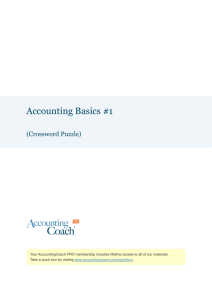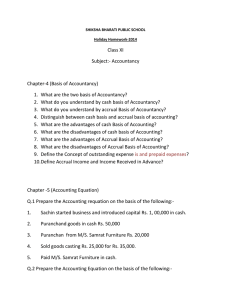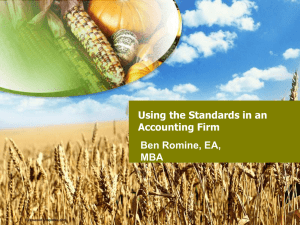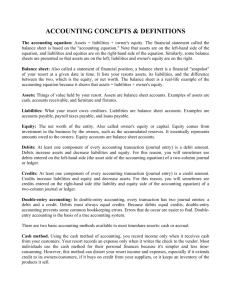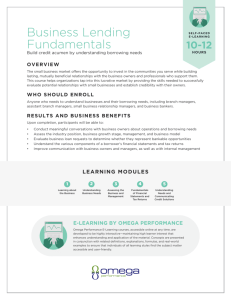Financial Accounting for Lenders
advertisement
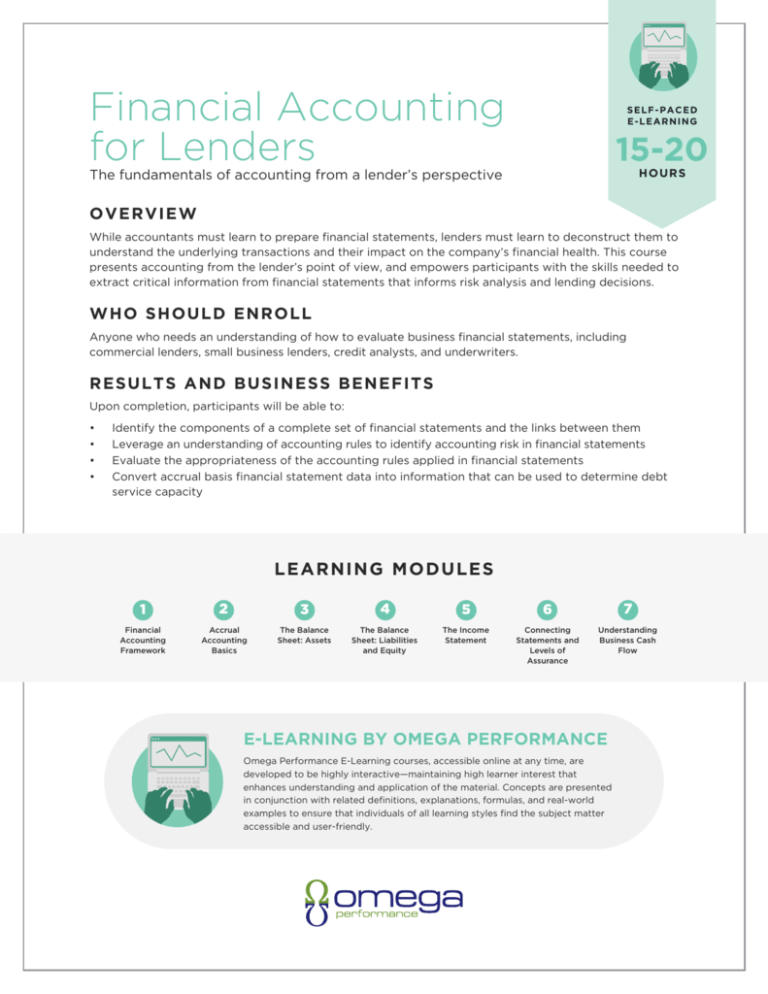
Financial Accounting for Lenders 15-20 The fundamentals of accounting from a lender’s perspective HOURS SELF-PACED E-LEARNING OVE RVIEW W H O S HOU L D ENR OL L RE S ULT S AND B US I NES S BE N E FI T S service capacity L E A RNING M O D ULES 1 2 3 4 5 6 7 Financial Accounting Framework Accrual Accounting Basics The Balance Sheet: Assets The Balance Sheet: Liabilities and Equity The Income Statement Connecting Statements and Levels of Assurance Understanding Business Cash Flow E-LEARNING By OMEGA PERFORMANCE developed to be highly interactive—maintaining high learner interest that Learning Module Descriptions 1 FINANCIAL ACCOUNTING FRAMEWORk 5 THE INCOME STATEMENT Reviews the function and structure of a typical income statement Introduces accounting standards and how they are developed Explains basic accounting system rules and measurements Describes common operating expenses and the calculation of oper- 2 ACCRUAL ACCOUNTING BASICS impact of each on taxable income Compares and contrasts cash and accrual accounting Demonstrates the evolution of the balance sheet and income statement of a start-up business Presents revenue and expense recognition methods and their sheet 6 CONNECTING STATEMENTS AND LEVELS OF ASSURANCE 3 THE BALANCE SHEET: ASSETS Describes the purpose and contents of the statement of shareholders’ equity and statement of retained earnings Presents an overview of balance sheet transactions and their effect on cash to the balance sheet and income statement amortization of intangibles and the impairment of goodwill statements Describes management and accountant responsibilities when pre- 4 THE BALANCE SHEET: LIABILITIES AND EqUITy statement and audit opinion Addresses the impact of liabilities on repayment of loans Provides an in-depth understanding of interest-bearing and noninterest-bearing liabilities 7 UNDERSTANDING BUSINESS CASH FLOW statements statement disclosure requirements for long-term debt Analyzes how timing differences in the operating and capital Describes the accounting treatment of operating and capital leases Compares and contrasts the presentation of equity for each type of business organization income statement and changes in the balance sheet Presents three perspectives on the analysis of equity Applies the analysis of sources and uses of cash to determine Demonstrates the calculation and fundamental analysis of indirect FIND OUT MORE ABOUT OMEGA PERFORMANCE TRAINING +1 703-558-4440 // solutions@omega-performance.com // omega-performance.com +65 6505-2060 // apacsolutions@omega-performance.com // omega-performanceapac.com Training Effectiveness Benchmarking Report Financial Accounting for Lenders Average Percentage Increase in Knowledge LEARNING MODULES 23% PRE-TEST SCORES POST-TEST SCORES 1. Financial Accounting Framework 71 93 2. Accrual Accounting Basics 67 93 3. The Balance Sheet: Assets 71 94 4. The Balance Sheet: Liabilities and Equity 76 95 5. The Income Statement 77 95 6. Connecting Statements and Levels of Assurance 68 92 7. Understanding Business Cash Flow 66 94 Key Takeaways 26% 67 28% 24% 93 68 Pre-Training Participants were lacking critical Financial Accounting for Lenders skills, such as the ability to explore a customer’s financial statements and analyze balance sheet fundamentals. 92 66 Accrual Ac ccrual Accounting Accoun nting Basics cs Connecting Conn nne e ecting ec g Statements Stateme ents & Levels Assurance Lev vels of Assura ance Pre-Test Post-Test 94 Unders Understanding rsta andin ng Businesss Cash h Flow w Increase in Knowledge The graph above displays the score data for the learning modules of Financial Accounting for Lenders in which participants display the greatest skill improvement, as demonstrated in the Pre-Test and Post-Test differential. OMEGA PERFORMANCE BENCHMARKING REPORT Post-Training Post-Test results highlighted an average 23% improvement in key skills. Participants demonstrated their ability to identify the asset conversion cycle of a business, the effect of slowdowns in that cycle, and the effects of the revenue and expense recognition methods used by a business. Further, participants were also able to describe the purpose and contents of all parts of a financial statement, and understand a statement of cash flows.



